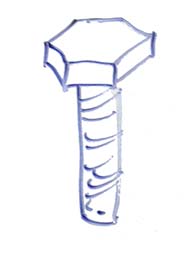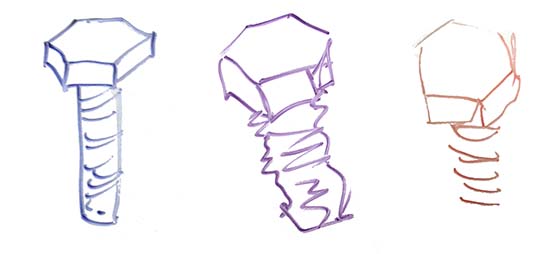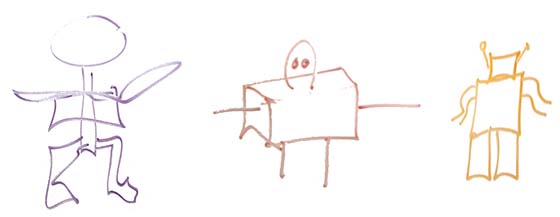Quick Draw is a drawing game. It is best played in a group of four to ten people. The drawings can be made on paper, but it’s really fun to play gathered around a whiteboard.
The game is quite simple. In each round of the game the players have to make a drawing, and then a point is awarded to the player who produces the best drawing. But there’s a catch…you only have five seconds to make your drawing.
In each round one person chooses what will be drawn, and everyone else draws. Once they have something in mind, and everyone else has their pens ready, they reveal their chosen subject aloud:
“Draw a…phone.”
…or a bus, or a tree, or a banana, or whatever they chose as the subject for this round.
Then, as the other players frantically draw, they provide a five second countdown.
“Five…four…three…two…one…STOP.”
After they say “stop” everyone must stop drawing or forfeit their chance of winning the round. Finally, they choose the best drawing. The person who’s drawing is chosen wins the round, and is awarded one point. This person then gets to choose the subject of the next round.
The choice of which drawing is best is clearly a subjective judgment, but quite often there is a clear winner. Otherwise, there is usually some discussion of the merits of each drawing, and people may argue against or in favor of a particular drawing, but the final decision always lies with the person who chose the subject.
The game can be played for a fixed number of rounds, or until someone reaches a certain number of points. The person with the most points at the end of the game is the winner.
Needless to say, five seconds is not much time to draw something, and even the winning drawings are typically pretty crude. In practice players often scratch out something that barely resembles the chosen subject by the end of the five seconds, and assume they’ve lost…until they glance around at the other drawings.
Here’s an example of a couple of typical rounds. Imagine the subject is
“Draw a…bolt.”
…and in five seconds you draw this:
 You’re pretty sure you’ve lost that round…until you look at the bolts everyone else drew:
You’re pretty sure you’ve lost that round…until you look at the bolts everyone else drew:

Lo and behold, your bolt is chosen as the best and you actually win the round. A point for you is recorded. Now it’s your turn to choose a subject.
“Draw a…robot.”
…and all the other players frantically draw their robots as you count down from five seconds:

Now you get to choose the robot you think is the best and the person who drew it takes your place.
The drawings above are examples of typical results from experienced players with reasonable drawing skills, so don’t worry if you don’t think your doodling abilities are good enough. You don’t need to be an amazing artist to play Quick Draw; in fact, great drawing skills might even be a disadvantage.
Once in a while, a player will spend the entire five seconds trying to decide how to draw the subject, and when time expires they are left with a blank canvas. Other times players will begin drawing immediately, but run out of space, have to backtrack, or try to erase something, and end up running out of time with only a bizarre unfinished scribble to show for themselves.
And that’s where the teachable lesson of the game lies. A lack of drawing skills is really no obstacle to winning at Quick Draw, because drawing is only a minor part of the game. The most important skill required to play Quick Draw is the ability to think and then act, both in a very limited amount of time.
This skill actually involves solving a particular kind of optimization problem; a problem that crops up not only in this game, but in many different facets of life.
Continued in The Quick Draw Game – Part 2 – Exploration and Exploitation
